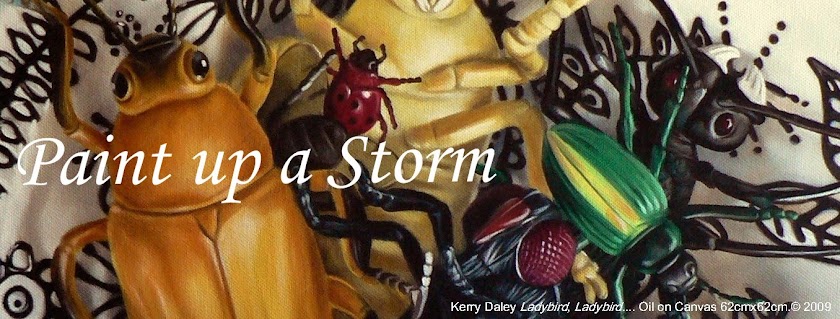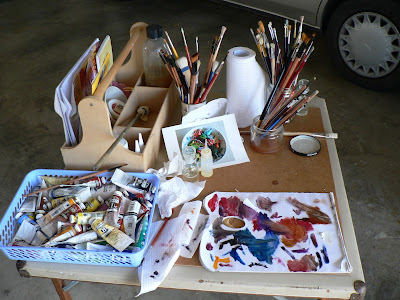So... I have trawled through my
sketchbooks, looked carefully at the
work of artists I admire, looked at nature and
the world around me and searched my inner thoughts and feelings. I have paged through my
Picture Notebook, and my
Trash Can Journal, and I have finally come up with a good idea for my painting. Clever me - can't wait to get the paints out and get going...
This is precisely how most of my paintings start - I look a bit, think a bit, get a good idea and before you can say "Leonardo Da Vinci", I have the basic design mapped out on my canvas, all my equipment set out and I'm up to my eyeballs in paint.
Let me tell you what happens next....
I paint with great gusto for 25 minutes
I stop to make a coffee
I prop the work up on my easel and stare at it while I drink my coffee
I wonder about the placement of one of the figures in the picture
I paint that figure for 10 minutes
I paint around that figure for 10 minutes
I go to the kitchen to make a sandwich
I eat my sandwich staring at the painting I have done so far
I take my plate back to the kitchen
I notice that there are dishes in the sink, I wash them
I go back to my easel and paint a bit of the background of my picture
I paint for another two minutes trying not to think
I stand back and have a little think
I paint a bit more of the background
I worry that the background is not right for the figures
I rinse out the brush I was using
I clean three other brushes while I am at it...and my palette knife
I wipe my palette a bit
I take a deep breath and make myself paint for another 25 minutes
I can't resolve the background
I quickly wipe off the background (I am working in oils here)
I wipe off the figure that was worrying me earlier too
I feel much better
I wipe off another few centimetres of another section of the painting
I paint over everything for 45 minutes
I stop to make a coffee
I prop the painting up on my easel to stare at while I drink my coffee
I wipe off the whole picture
I take my cup back to the sink
I feel much worse
I wash my cup
I look at my watch and realise that I need to fetch my daughter from school
I dash off to school
6 hours later, when everyone is in bed, I clean up my paints and palette
I put the canvas away and my easel
I take out my old
sketchbooks, and my Trash Can journal, I open my Picture Notebooks
I start looking through them
Looking for...a NEW idea
Wait a minute...
I had a good idea. I liked my idea, it excited me, it had me running to my easel. I could imagine it as a painting. What happened?
What happened is this: I did not check to see if my good idea was a great idea. I did not go through any of the steps that I need to go through before I start to paint. I did not work on my good idea. Of course it could have been much worse. I could have been painting for several weeks before I wiped it all off. It would not have been the first time.
So...if you have a good idea like me, here is the very first thing you need to do before you start painting:
Do Nothing!
Live with your idea for a few days.























